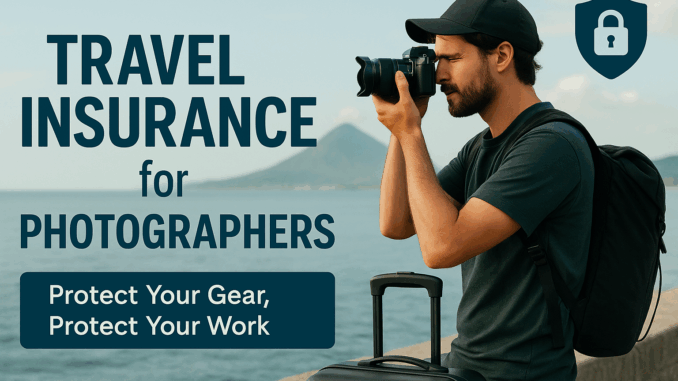
In the world of travel photography, protecting your trip goes far beyond flight delays and lost luggage. You’re traveling with thousands of dollars in gear, and your ability to deliver on time often depends on everything running smoothly. When things go off track, travel insurance becomes a critical safety net.
Whether you’re heading out for a paid assignment, exploring remote landscapes, or simply bringing your camera along on vacation, travel insurance is one of the most overlooked—and essential—parts of being a photographer on the move.
Here’s what you need to know about travel insurance for photographers, why it matters, and how to make sure you’re fully covered.
Why Photographers Need Travel Insurance:
- Gear Protection: Cameras, lenses, drones, and laptops are expensive. Lost, stolen, or damaged gear can end a trip (and an assignment) in an instant.
- Liability Coverage: If you injure someone accidentally or damage property while shooting, you could be financially responsible.
- Medical Coverage: If you’re traveling internationally, your regular health insurance might not cover you abroad. Injuries or illness can be wildly expensive without it.
- Safeguard Your Income: When you’re on assignment or scheduled shoots, trip cancellations or delays can mean lost jobs and missed deadlines. Insurance can help you recover these losses.
- Data recovery: Some specialized plans can cover costs for recovering lost or corrupted image files, which is critical if you’re on assignment.
Who Needs To Be Insured?
- You (the photographer): For health, accidents, and your personal belongings.
- Your Gear: Either through travel insurance add-ons or standalone professional equipment insurance.
- Your Team: If traveling with assistants or second shooters, stylists, etc., make sure they’re covered too.
- Your business: If you’re traveling under your business name or on client work, make sure your business liability insurance is valid in the destination country.
-
Where Should Photographers Buy Travel Insurance?
For full protection, many photographers carry both travel insurance (for health and trip coverage) and professional photographer insurance (for gear and liability). They serve different needs and both are important.
There’s no one-size-fits-all answer, but here are some solid options photographers trust:
General travel insurance providers:
- World Nomads – popular with photographers, creatives, and adventure travelers. They cover gear, health, and trip protection with flexible policies.
- SafetyWing – more affordable for long-term travel, with decent health coverage, but limited gear protection unless you add riders.
- Allianz Global Assistance – more traditional, good for trip interruption and health, but check gear limits.
- Travel Guard (AIG) – similar to Allianz, with customizable options. Good for trip interruption and emergency medical, but double-check equipment coverage.
- Travelex – good all-around, but again, check gear limits. Balanced coverage with optional upgrades.
Photographer-specific insurance:
- Professional Photographers of America (PPA) – includes equipment insurance and general liability for members.
- Hill & Usher “Package Choice” – designed for professional photographers, with comprehensive business and travel protection.
- American Photographic Artists (APA) – offers tailored insurance options for members, particularly geared toward commercial photographers.
- TCP Insurance – covers media professionals and creative freelancers.
Key Considerations For Photographers:
Gear Limits:
Many standard travel policies have low caps on electronics (like $500 per item). That’s not enough for a camera body or lens. Look for policies with:
- Higher single-item limits (ideally $3,000+ per item).
- Options to schedule specific pieces of equipment by serial number.
Worldwide Coverage:
Ensure the policy covers all countries you’re traveling to, and check for restricted areas or war zones if you’re traveling somewhere remote or politically unstable.
Professional Use:
Some travel insurance excludes coverage if you’re working, even if it’s a “working vacation.” If you’re photographing for clients, selling the images, or on assignment, make sure your policy covers work-related travel.
Liability Protection:
If you’re photographing models, clients, or in public spaces, general liability is a must. It protects you if someone gets hurt or property gets damaged while you’re working.
Medical Evacuation:
For remote locations, you might need emergency evacuation coverage, which can be a literal lifesaver. Companies like Medjet or Global Rescue specialize in getting you home safely.
Drone Coverage:
Many insurers exclude drones or have strict conditions for coverage. If you’re flying, you’ll likely need a specialized rider or separate drone insurance.
Other things to consider:
- Backup your files often. Insurance can replace a camera, but not your once-in-a-lifetime images.
- Use AirTags or other trackers in your gear bags.
- Keep digital and physical copies of serial numbers and receipts to make filing claims easier.
- Review your policy carefully and understand how to file a claim—before you leave home.
Final Thoughts
When selecting travel insurance, it’s essential to consider worldwide coverage, customizable plans for short and long trips, high coverage limits for gear, low deductibles, and 24/7 assistance with an easy claims process.
Before your next trip, take a little time to assess your needs and make sure you’re covered from every angle—so you can focus on creating your best work, knowing you’ve got a safety net in place.

[…] finally, be sure you have travel insurance. Don’t skip it! Many providers like World Nomads or SafetyWing cover trekking-specific […]
[…] finally, be sure you have travel insurance. Don’t skip it! Many providers like World Nomads or SafetyWing cover trekking-specific […]